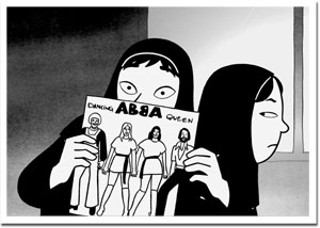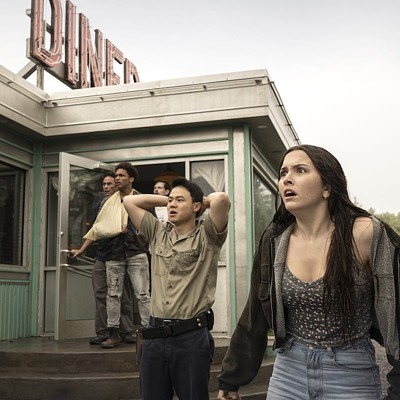Adapting a graphic novel for the big screen is a double-edged sword. Whats there on the page has a visual style that informs the filmmaker, but the screenwriter must distill the story from drawings and dialogue, and tone and feeling.
Academy-nominated Persepolis, the film adapted from Marjane Satrapis graphic novels that is screening in Halifax this Monday, recounts the authors childhood during the Iranian Revolution. Satrapi wrote and directed the film with French comic artist and filmmaker Vincent Paronnaud, which gave her control over what she wanted to translate from page to screen---the most obvious example being her simple, innocent-looking drawings.
With Persepolis in mind, there are certain elements to remember when adapting a graphic novel to film:
A picture is worth a thousand more words than dialogue. Artwork in graphic novels takes the place of narration in conventional novels. Screenwriters require an eye for artistic convention as keen as their ear for dialogue. When adapting a graphic novel, the screenwriter is at the mercy of the choices the artist has made, as much as the choices of the writer. The film version of Harvey Pekars American Splendor comic series plays up the many renderings of the author by different artists over the years ---Pekar shows up as himself, actor Paul Giamatti portrays Pekar and actual American Splendor strips are used---all in the same movie.
Sometimes the work is done for you.
Like any source material, there are certain scenes that beg to be put on film. From Hell, the thick Jack the Ripper tome by Alan Moore and Eddie Campbell, features a series of panels drawn from the same birds-eye view, showing the body of the first Ripper victim strewn in the street. The scene features only incidental dialogue---the first to discover the victim assumes shes a drunk and carries on---while it passively follows as policemen and onlookers eventually converge and a circus ensues. The film version of From Hell, directed by Allen and Albert Hughes, translates the scene with time-lapse photography and ominous, low-rumbling music.
A strip-length plot does not a fully formed character make. Ghost World, the novel by Daniel Clowes, provided the exact looks and personalities of characters Enid and Rebecca for the film, but the screenplay takes segments from the novel and runs further with them. Enid and Seymour have only one scene together in the novel, when Enid and Rebecca jokingly answer Seymours personal ad and spend an agonizing lunch watching him wait in vain for his mystery date. But in the film they develop a relationship after Enid tricks him and goes to his garage sale as penance.
Follow the money. Superheroes are ideal subjects for major film studios: recognizable characters that have been around for decades, offering fantasy and thrills. Studios also have a taste for high-drama comics and graphic novels, such as Road to Perdition and A History of Violence. These films are not necessarily superhero stories, but archetypal narratives about the adversity of overcoming the past and tension among families. Both films were nominated for Academy awards; Perdition won for Conrad L. Halls cinematography, while A History celebrated nominations in the Best Supporting Actor category (William Hurt) and Adapted Screenplay.
Relax---movies and comics arent as different as you might think. Image and story---arent those the two guiding principals of both forms? Michael Chabons (conventional) novel The Amazing Adventures of Kavalier & Clay is about two comic authors in the 30s and 40s. In 1941, Joe Kavalier and Sammy Clay have a revelation watching Citizen Kane: It was that Citizen Kane represented, more than any other movie Joe had ever seen, the total blending of narration and image that was---didnt Sammy see it?---the fundamental principle of comic book storytelling.... In this one crucial regard---its inextricable braiding of image and narrative ---Citizen Kane was like a comic book.
Graphic novels have their look, their image on the page. The director gets the easy job. The writer has to give a graphic novel a close appraisal to refine the story for the movies.












